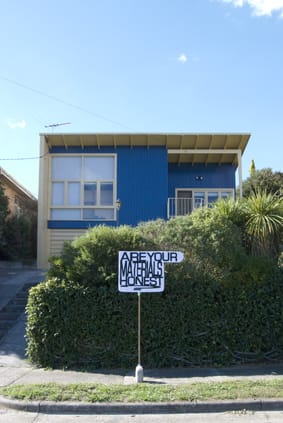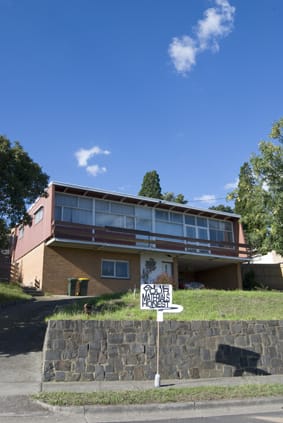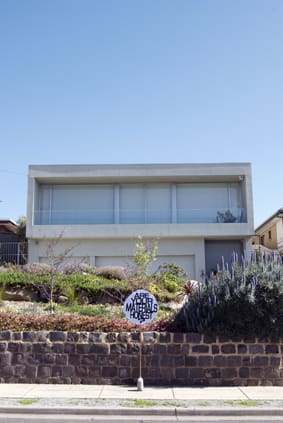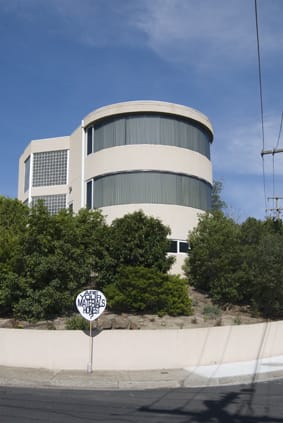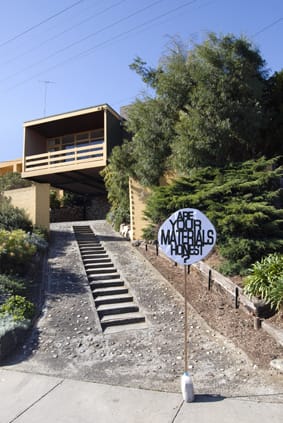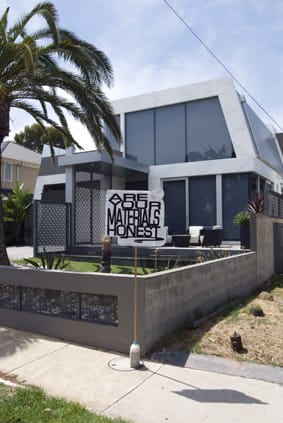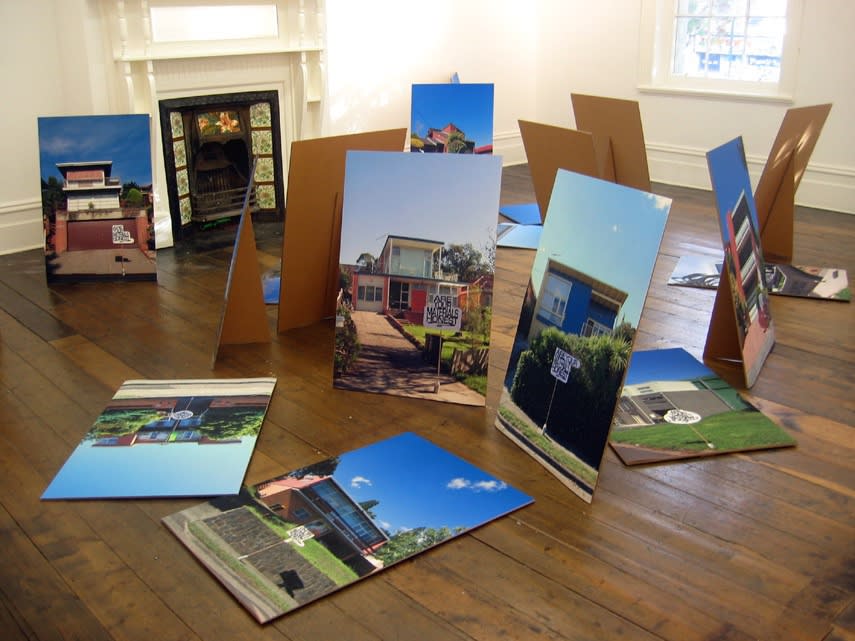Simone Slee: Houses that are happy to help with at least one of the possible problems of art
Sculpture. Questions.
Simone Slee drives through her neighbourhood, stops in front of particular houses, puts up a sign with the inscription ‘Are Your Materials Honest?’ and takes a photograph of the scene. Nobody sees her. The streets are empty and the houses’ inhabitants don’t show or are absent.
The houses in a Melbourne suburb stand monolithic like sculptures by the side of the road or in the middle of a landscape. Slee’s small self-made signs stand in front, asking shyly, but also confidently the question, just like a child asks an adult: ‘Where do clouds come from?’ In milk bottles filled with sand, the signs stand solidly; simple everyday bottles just like the ones the milkman brings to the door in the mornings. This sculpture belongs to a series of works, begun in 2006 with the installation titled Help a sculpture at Gallery Wildwechsel in Frankfurt. Here a wobbly cardboard circle, covered with aluminium foil, was kept upright by means of a plastic bag filled with water, inside of which a fish was swimming. Every now and then, when the fish was put back into an aquarium, the circle fell over. In another series of works from 2008, Slee again confronts the spectator with a simple question and we behold the artist amidst nature or in cityscapes holding up a sign with the inscription ‘How long can I hold this up?’
Slee’s multi-layered work bears references to some of the great contemporary oeuvres of artists explicitly working with image and text, namely the Truisms of Jenny Holzer, Lawrence Weiner’s Statements or even Ed Ruscha’s We Played House for 3 Years. Yet, rather than pointing an aphoristic finger, Slee highlights the discursive process by posing outright questions.
Are your materials honest? The question is quickly asked, but difficult to answer. When at art academy we always asked ourselves whether materials are being used in the propper way. There were unwritten laws that a proper painting had to be done either in acrylics, or even better, in oil on canvas, at the very least, a painting had to be painted in tempera; in any case it had to be executed ‘true to the material’/’materialgerecht’ somehow. This might still have something to do with the bauhaus idea of ‘form follows function’ propagated at art and design schools since the 1920s. The work of Slee, on the other hand, appears free of these deliberations: The artist sticks aluminium foil onto cardboard, balances this with a bag of fish and begins an imaginary dialogue between houses, sculptures and the spectator; much like Ad Reinhardt has done in a cartoon, when he let the picture ask of the spectator ‘Hahaha, what do YOU represent?’(1946). In Reinhardt’s work this question took the form of a thought bubble in an American magazine; more than sixty years later in Slee’s work the thought bubble becomes a performative sculpture in the Australian suburbs.
At the exhibition Sculpture Projects – Muenster, Elmgreen and Dragset showed Drama Queens, a play staged with several characters, where among others a sculpture by Alberto Giacometti, Walking Man, encounters a sculpture by Barbara Hepworth as well as Jeff Koons’ Rabbit. A real conversation somehow isn’t happening, as each sculpture is talking about being better than the rest. The play was staged as part of the big survey show at the local theatre, in a safe haven so to speak. Slee, however, can’t hope to find a favourable audience in the suburbs. Instead she photographs the entire scene and creates a new sculpture from it. The photograph is printed poster-size with an ink-jet printer and mounted onto a cardboard frame, a cardboard flap on the back keeping it upright.
In Frankfurt, where I live and work, on many houses one can see ‘For Rent’– or ‘For Sale’– signs and it is refreshing to see a sign asking an odd question, one that has nothing to do with fiscal transactions or financial gain in front of a house for a change.
Oscillating with Duchampian irony between Appropriation Art, sculpture and performance, Slee’s sculpture (by her own account) has been inspired by Douglas Huebler’s photographs of anonymous crowds where, in 1977, Huebler wrote ‘At least one person who might feel pleased to have been made the subject of art’. Slee inverts the relation between work and spectator, integrating the spectator in the production of the work itself. In case of ‘Are Your Materials Honest?’ the misappropriation of honesty to the materials itself grants an agency or a human character to materials as well as to the form the materials take, i.e. the house. In a tongue-in-cheek way, something inanimate suddenly becomes animated.
Describing the fusion of semiotics, advertisement and art in one small speech-bubble Slee’s ‘Are Your Materials Honest?’, much like Bruno Latour in ‘Mixing Humans and Nonhumans Together (1), addresses the complexity of social interaction by means of choosing a humble house to illustrate that it is a ‘highly moral, highly social actor that deserves careful consideration’.
Who knows whether houses might not be able to have conversations and whether fish don’t enjoy holding up sculptures?
Andreas Exner
Frankfurt am Main, April 2010
NOTE:
1 ‘Mixing Humans and Nonhumans Together: The Sociology of a Door-Closer’, Author(s): Jim Johnson. Source: Social Problems, Vol. 35, No. 3, Special Issue: The Sociology of Science and Technology (June 1988), pp. 298-310 Published by: University of California Press on behalf of the Society for the Study of Social Problems.
-
 Simone Slee, Houses Happy to Help #1, 2010
Simone Slee, Houses Happy to Help #1, 2010 -
 Simone Slee, Houses Happy to Help #10, 2010
Simone Slee, Houses Happy to Help #10, 2010 -
 Simone Slee, Houses Happy to Help #11, 2010
Simone Slee, Houses Happy to Help #11, 2010 -
 Simone Slee, Houses Happy to Help #12, 2010
Simone Slee, Houses Happy to Help #12, 2010
-
 Simone Slee, Houses Happy to Help #13, 2010
Simone Slee, Houses Happy to Help #13, 2010 -
 Simone Slee, Houses Happy to Help #14, 2010
Simone Slee, Houses Happy to Help #14, 2010 -
 Simone Slee, Houses Happy to Help #15, 2010
Simone Slee, Houses Happy to Help #15, 2010 -
 Simone Slee, Houses Happy to Help #16, 2010
Simone Slee, Houses Happy to Help #16, 2010
-
 Simone Slee, Houses Happy to Help #17, 2010
Simone Slee, Houses Happy to Help #17, 2010 -
 Simone Slee, Houses Happy to Help #18, 2010
Simone Slee, Houses Happy to Help #18, 2010 -
 Simone Slee, Houses Happy to Help #19, 2010
Simone Slee, Houses Happy to Help #19, 2010 -
 Simone Slee, Houses Happy to Help #2, 2010
Simone Slee, Houses Happy to Help #2, 2010
-
 Simone Slee, Houses Happy to Help #20, 2010
Simone Slee, Houses Happy to Help #20, 2010 -
 Simone Slee, Houses Happy to Help #21, 2010
Simone Slee, Houses Happy to Help #21, 2010 -
 Simone Slee, Houses Happy to Help #22, 2010
Simone Slee, Houses Happy to Help #22, 2010 -
 Simone Slee, Houses Happy to Help #23, 2010
Simone Slee, Houses Happy to Help #23, 2010




